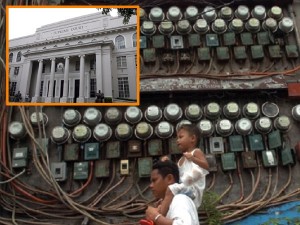
INQUIRER FILE PHOTO
MANILA, Philippines—Consumers will have to wait a few more days for the results of government regulators’ probe into alleged collusion among generators of electricity as largely being behind a record P4.15/kWh power rate hike that has been deferred on orders of the Supreme Court.
An investigative unit within the Energy Regulatory Commission is set to present its findings to members of the commission on January 6.
The ERC, together with the Department of Energy and electricity spot market operator Philippine Electricity Market Corp. was set to finish today, Monday, its data gathering and investigation as what actions were taken by the power generation companies and distribution utility Manila Electric Co. that led to the record hike and whether these constituted collusion or not.
“We will have to wait for a report to be presented to the commission by the investigating unit by January 6,” ERC commissioner Josefina Patricia Magpale-Asirit said when asked about the likely result of the probe.
Asirit said January 6 is first commission meeting for the year 2014. “We have our regular meetings every Monday,” she said.
The DOE, for its part, is leaving the probe to ERC, citing existing laws.
“It is the ERC that is the legal entity for the probe under EPIRA (Electric Power Industry Reform Act of 2001, which privatized the sector). As far as data gathering is concerned, it’s tripartite. However, the investigation, officially, is with the ERC,” Energy Secretary Carlos Jericho Petilla said in a text message.
Aside from the ERC-DOE-PEMC probe, the Senate and the House of Representatives have also conducted hearings on the controversial electricity rate increase.
The looming staggered increase in Meralco customers’ bills, while easing cash flow for electricity consumers, could very well indicate a new norm of higher power prices.
“The staggering helps the cash-flow but it does not lessen the pain. I also think that investors will really think twice to come into the country if we do not improve our planning,” Philippine Chamber of Commerce and Industry vice-chairperson Donald Dee said in a text message. PCCI is the country’s largest group of business leaders.
Industry estimates show that such costs for power-intensive businesses could increase by 25 percent to 35 percent. The power content of their total production cost could be as much as 25 percent to 30 percent. As such, their margins and cash flow would drop by 8 percent to over 10 percent.
So-called power intrusive businesses are manufacturers of home appliances, makers of ready-to-wear items, textile mills, cement, restaurants, malls, electronics processors, outsourcing and IT firms, and most exporters who are in process of filling up orders taken at fixed prices months ago.
Jose Alejandro, PCCI vice-president for energy, said this may trigger temporary reduction of labor cost to even up, hence temporary unemployment for the temporay workers of three to four months.
“Long-term investors, especially foreign and new ones, would be hard put in considering expansion if they do not gain a good level of confidence that our power cost would be predictably stable and not subjected to surprising and jolting increases or even power supply and quality deficiency. Short-term investors would remain basically opportunistic and avoid long-term commitments,” he said.
Socioeconomic Planning Secretary Arsenio Baliscan has said that the increase in power rates would impact spending and manufacturing, which had helped boost industrial activity.